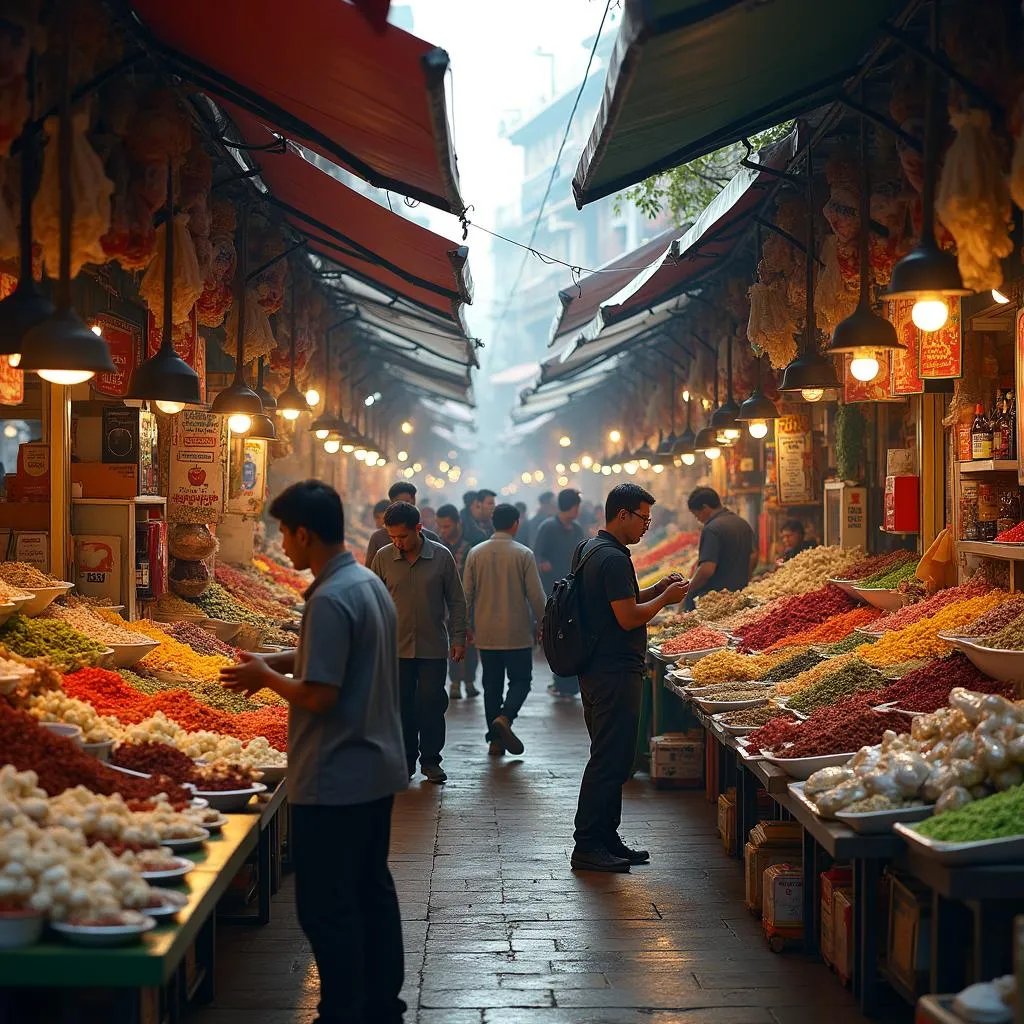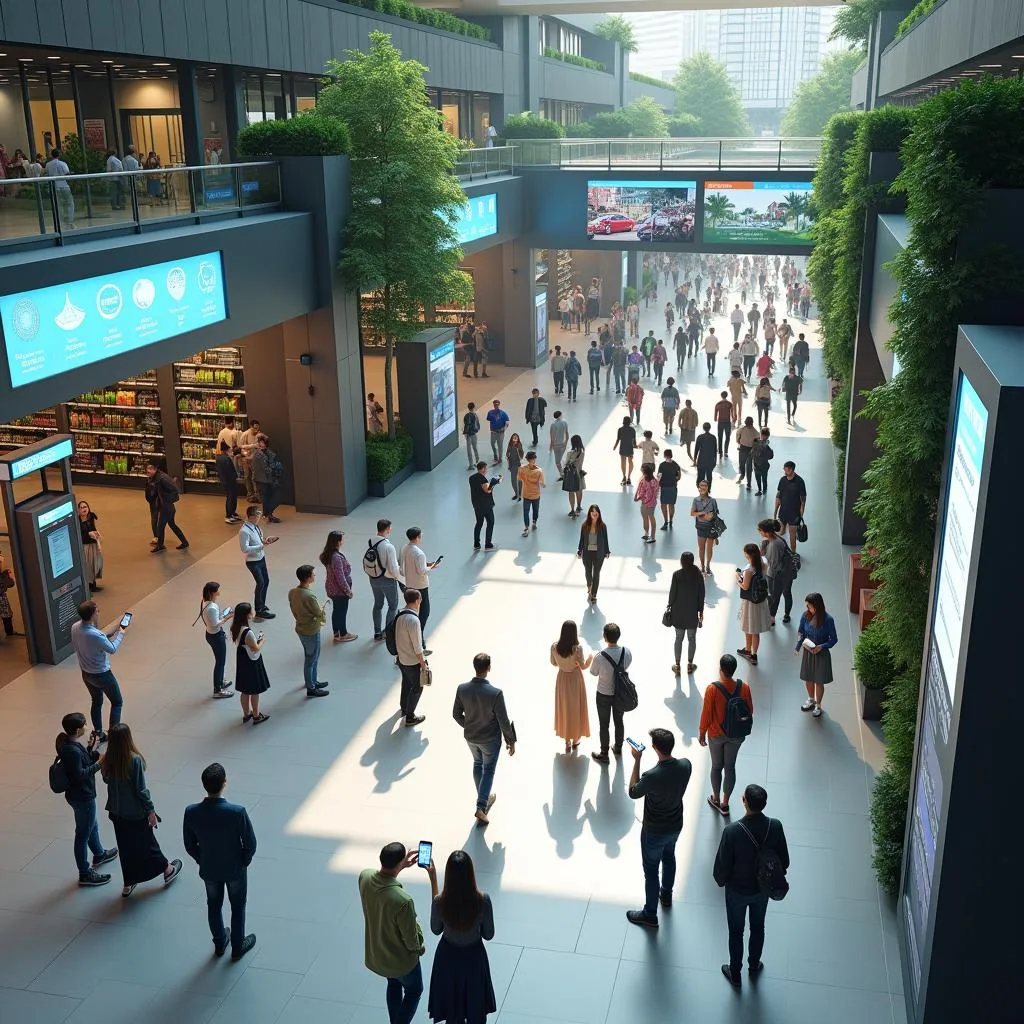IELTS Speaking tasks often include describing familiar places, and one common topic is discussing crowded areas you frequently visit. This subject allows examiners to assess your ability to describe environments, express personal experiences, and discuss social interactions. Let’s explore how to effectively tackle this topic in your IELTS Speaking exam.
Describe an exciting activity you experienced can be another interesting topic to prepare for your IELTS Speaking test. However, let’s focus on describing a crowded place for now.
Part 1: Introduction and Interview
In this section, the examiner may ask general questions about crowded places. Here’s a sample question with a suggested answer:
Q: Do you often go to crowded places?
A: Yes, I do find myself in bustling areas quite frequently. Living in a big city, it’s almost unavoidable. I often visit popular shopping malls during weekends and busy markets for grocery shopping. While the crowds can be overwhelming at times, I’ve learned to navigate them efficiently.
Part 2: Long Turn (Cue Card)
Here’s a possible cue card for this topic:
Describe a crowded place you often visit
You should say:
- Where this place is
- Why you go there
- What you do there
- And explain how you feel about this crowded place
Sample answer (Band 8-9):
“I’d like to talk about a vibrant and bustling place I frequently visit – the central market in my city. Located in the heart of downtown, this market is a hive of activity that attracts locals and tourists alike.
I often go there for various reasons. Primarily, it’s my go-to spot for fresh produce and unique local specialties. The market offers an incredible array of fruits, vegetables, spices, and artisanal products that are hard to find elsewhere. Additionally, it’s a great place to immerse myself in the local culture and observe the daily life of city dwellers.
When I’m there, I usually start by wandering through the maze-like alleys, taking in the sights, sounds, and aromas. I enjoy haggling with vendors for the best prices on fresh ingredients for my weekly meals. Sometimes, I’ll pause at one of the small food stalls to sample some street food or have a quick coffee while people-watching.
My feelings about this crowded place are quite mixed. On one hand, the energy and vibrancy are incredibly invigorating. There’s always something new to discover, and the hustle and bustle can be exciting. The diversity of people and products never fails to fascinate me. On the other hand, the crowds can be overwhelming at times, especially during peak hours. Navigating through the narrow pathways can be challenging, and the noise levels can be quite high.
Despite these challenges, I find that the positives outweigh the negatives. The market offers a unique sensory experience that I’ve come to appreciate. It’s not just a place for shopping; it’s a microcosm of urban life that reflects the city’s character and diversity. Each visit feels like a small adventure, and I always leave with a sense of satisfaction, whether from the products I’ve purchased or the experiences I’ve had.”
 Bustling activity in a crowded market
Bustling activity in a crowded market
Follow-up questions:
Q: How do you manage to stay calm in such a crowded environment?
A (Band 6-7): I try to go during less busy times and plan my route through the market. Taking deep breaths and focusing on my tasks helps me stay calm. If it gets too much, I’ll take a short break in a quieter area.
A (Band 8-9): I’ve developed several coping strategies over time. Firstly, I practice mindfulness to stay centered amidst the chaos. I also time my visits strategically, avoiding peak hours when possible. Additionally, I’ve learned to embrace the energy of the crowd rather than resist it, which has significantly reduced my stress levels.
Part 3: Two-way Discussion
Q: Why do you think some people enjoy crowded places while others avoid them?
A (Band 6-7): I think it depends on personality types. Some people like the excitement and energy of crowds, while others prefer quiet and calm environments. Also, past experiences can affect how comfortable someone feels in busy places.
A (Band 8-9): The preference for or aversion to crowded places is often a complex interplay of psychological and sociological factors. Extroverted individuals tend to thrive on the energy and stimulation that crowds provide, viewing them as opportunities for social interaction and novel experiences. Conversely, those with more introverted tendencies might find such environments overwhelming and emotionally draining.
Cultural background also plays a significant role. In some societies, bustling public spaces are seen as vibrant and desirable, while in others, personal space is highly valued. Additionally, past experiences and associations with crowded places can shape one’s comfort level. Positive encounters might foster an affinity for busy environments, while negative ones could lead to avoidance behaviors.
It’s also worth noting that the context of the crowd matters. A person might enjoy the atmosphere of a crowded concert but feel stressed in a packed subway car. Ultimately, the individual’s ability to regulate sensory input and their overall stress tolerance are crucial factors in determining their response to crowded environments.
Describe a garden you have visited and liked could be a contrasting topic to discuss after talking about crowded places, offering a change of pace in your speaking practice.
Q: How have crowded public spaces changed in recent years?
A (Band 6-7): In recent years, crowded places have become more diverse and technologically advanced. We see more security measures and digital systems for managing crowds. Also, there’s been a shift towards creating more open spaces in busy areas to help with crowd flow.
A (Band 8-9): The evolution of crowded public spaces in recent years has been marked by several significant trends. Firstly, there’s been a notable shift towards integrating smart technologies to manage crowd flow and enhance user experience. This includes the implementation of AI-powered surveillance systems, real-time occupancy monitors, and mobile apps that provide information on crowd density and wait times.
Sustainability has also become a key focus, with many public spaces incorporating green design elements to mitigate the environmental impact of large gatherings. This often involves improved waste management systems, energy-efficient lighting, and the integration of green spaces within urban environments.
The COVID-19 pandemic has accelerated certain changes, leading to a greater emphasis on health and safety measures. We’ve seen the widespread adoption of contactless technologies, improved ventilation systems, and flexible space designs that can easily adapt to social distancing requirements when necessary.
Moreover, there’s been a growing trend towards creating multi-functional spaces that cater to diverse demographics and activities. This reflects a broader societal shift towards inclusivity and accessibility, ensuring that public spaces are welcoming to people of all ages, abilities, and cultural backgrounds.
 Smart technology for crowd management in public spaces
Smart technology for crowd management in public spaces
Key Vocabulary and Phrases for High Scores
-
Bustling /ˈbʌs.lɪŋ/ (adjective): Full of activity, busy.
Example: The market was bustling with shoppers on Saturday morning. -
Vibrant /ˈvaɪ.brənt/ (adjective): Full of energy and life.
Example: The vibrant atmosphere of the festival attracted thousands of visitors. -
Hive of activity (idiom): A place that is very busy or crowded.
Example: The city center becomes a hive of activity during the holiday season. -
Immerse oneself (phrasal verb): To become completely involved in something.
Example: I love to immerse myself in the local culture when I travel. -
Haggle /ˈhæɡ.əl/ (verb): To negotiate prices.
Example: It’s common to haggle over prices in many street markets. -
Invigorating /ɪnˈvɪɡ.ər.eɪ.tɪŋ/ (adjective): Making you feel energetic and healthy.
Example: The invigorating atmosphere of the city always lifts my spirits. -
Hustle and bustle (idiom): Busy and noisy activity.
Example: I enjoy the hustle and bustle of big city life. -
Microcosm /ˈmaɪ.krə.kɒz.əm/ (noun): A small place, society, or situation that has the same characteristics as something much larger.
Example: The market is a microcosm of our diverse city.
Describe an outdoor market in your city is another topic where you can apply these vocabulary items and phrases effectively.
Examiner’s Advice
To excel in describing crowded places in your IELTS Speaking test:
- Practice vivid descriptions: Use sensory details to paint a picture with your words.
- Develop a range of vocabulary: Incorporate advanced words and idiomatic expressions related to crowds and busy environments.
- Structure your answer: Organize your thoughts logically, addressing all parts of the question.
- Express personal opinions: Share your feelings and reflections about the crowded place.
- Use a variety of grammatical structures: Demonstrate your language proficiency with complex sentences and diverse tenses.
- Prepare examples: Have personal anecdotes ready to illustrate your points.
- Stay relevant: Keep your answer focused on the question, avoiding unnecessary tangents.
Remember, the key to a high score is not just what you say, but how you say it. Aim for fluency, coherence, and a natural conversational style while showcasing your language skills.
Describe a market you often visit can be an excellent topic to practice these skills, as it closely relates to describing crowded places.
By following these guidelines and practicing regularly, you’ll be well-prepared to tackle questions about crowded places in your IELTS Speaking test with confidence and eloquence.


